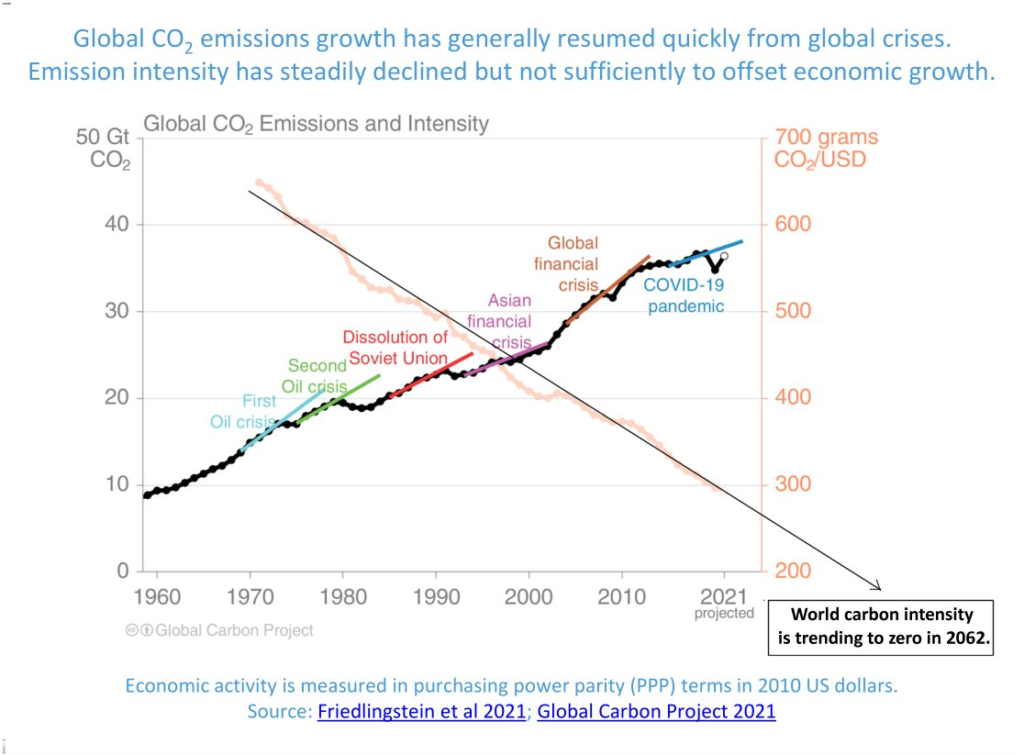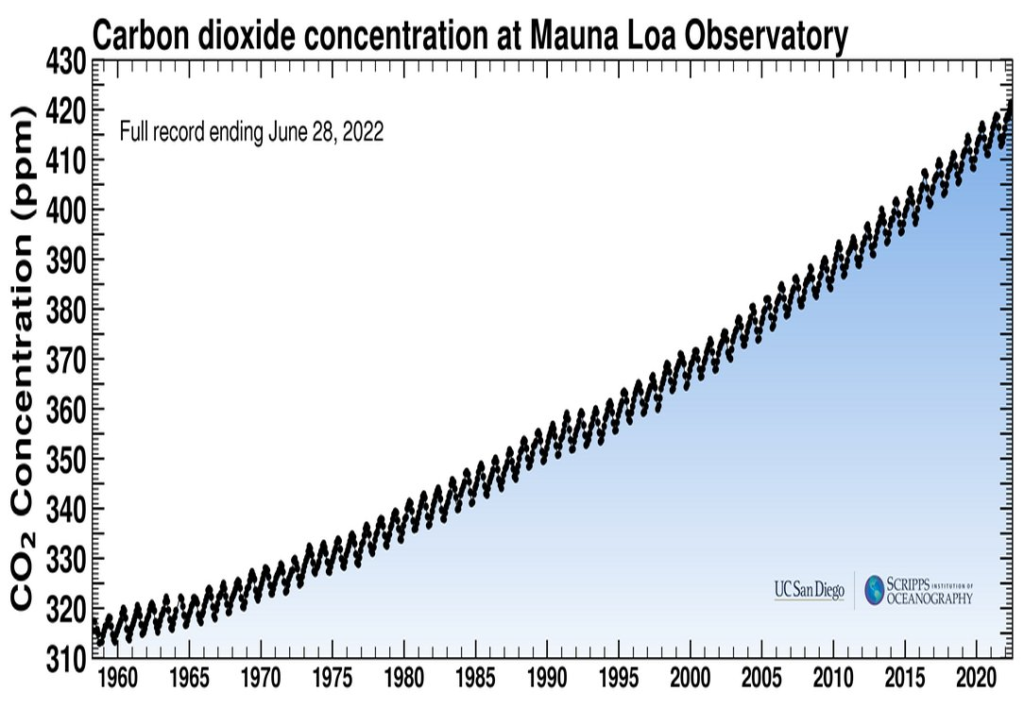Green Growth or Degrowth?
This post sets aside the concerns of the previous post, Net-zero is not good enough. This post discusses strategies to get to net-zero – the time when residual emissions of greenhouse gases are balanced by their removal. It relies on two excerpts from the Global Carbon Project 2021– plus an estimate of future economic growth from the International Monetary Fund.

Carbon intensity
The link between greenhouse gas emissions and economic activity (GDP) is strong: The greater GDP, the greater the emissions of greenhouse gases.
There is a simple factor, which helps understanding of this relationship. It is the carbon intensity of economic output, a measure of the amount of CO2 emitted (in grams CO2) for every unit of economic output (e.g. in £). Worldwide it’s presently over 500 grams CO2 for every £ of economic output produced.
As seen in Figure 1, global carbon intensity has more than halved since 1970. If this trend were to continue carbon intensity would reach zero in about 40 years – in 2062. This sounds like good progress as it predicts that CO2 emissions in 2062 will be zero – however large the world GDP is by then. But there is a problem: Before carbon intensity becomes zero, the amount of CO2 emitted may have overwhelmed the climate.
Carbon budgets
The Paris Agreement aimed to keep the rise in the Earth’s surface temperature to as near 1.5◦C as possible. That means the total CO2 that can emitted is limited. The limit is called the remaining carbon budget. The has made estimates of budgets for different limits to Earth’s surface temperature:
The remaining carbon budget for a 50% likelihood to limit global warming to 1.5, 1.7, and 2◦C has respectively reduced to 420 GtCO2, 770 GtCO2 and 1270 GtCO2 from the beginning of 2022, equivalent to 11, 20, and 32 years, assuming 2021 emissions levels.
Global Carbon Budget 2021, P. Friedlingstein et al.
In the medium term, the annual growth of worldwide GDP predicted by the International Monetary Fund is 3.3%. If this trend continues and carbon intensity falls steadily to zero in 40 years, the CO2 emitted will be enough to give a rise in surface temperature of 2.0◦C. This matches the worst target of the Paris agreement (1).
Another way to keep carbon emissions within the carbon budgets is to cut GDP. That’s degrowth. If the downward trend in carbon intensity remained at its historic value, to keep the Earth’s average surface temperature below 1.5◦C would require world GDP to shrink by more than 5% each year, destroying the economy in a few years.
Green Growth and Degrowth are outcomes – not policy options
Two main ideas about avoiding the climate the crisis and destroying the economy are Green Growth and Degrowth.
Advocates of Green Growth believe that the world economy needs to keep growing and solutions to the climate crisis can be found. Advocates of Degrowth believe a contraction of economic activity is necessary.
The two are often seen as opposing policy options.
A different perspective would see neither Green Growth or Degrowth as policy options but as possible outcomes of policy decisions. For example, consider a policy, that aimed at a maximum surface temperature rise of 1.5C. This policy would set maximum carbon emissions at 420 billion tonnes CO2 as calculated by the Global Carbon Budget 2021.
A question then arises: What is the maximum rate of increase in GDP that can be achieved without breaching the limit on carbon emissions of 420 billion tonnes?
Answer (based on GCB Fig 1): It’s a growth rate of -5.2%. That’s heavy Degrowth.
Currently carbon intensity is 540 gm of CO2 for each £ of GDP (2). If carbon intensity could be reduced twice as quickly (zero intensity in 2042), then what rate of economic growth is possible?
Answer: 0.1% economic growth is just possible. i.e. Maintaining the status quo.
If carbon intensity could be reduced 3 times faster (zero intensity in 2035), then what rate of economic growth is possible?
Answer: 10.2% economic growth is possible. That’s definitely Green Growth.
Neither Green Growth or Degrowth should be the starting point for policy options: The aim should be to keep within environmental limits and find how much economic growth is possible.
The historic trend of declining economic intensity must be greatly increased to achieve net-zero emissions in time to keep within carbon budgets and allow economic growth.
Signs aren’t good. Still little sign of atmospheric concentrations of CO2 falling.

TrackBack URL :
